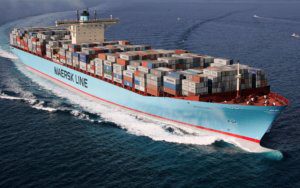
Industrial production in Ukraine in April 2018 increased by 3% compared with April 2017, while the figure in March 2018 year-over-year was 1%, it was 1.9% in February 2018 and 3.6% in January 2018, the State Statistics Service said on Wednesday.
The authority said that with the adjustment to the effect of calendar days, industrial production in April 2018 rose by the same 3% compared with April 2017, whereas growth in March 2018 from March 2017 was by 1.6%.
Industrial production in April 2018 from March 2018 decreased by 5%, and the drop was 0.6% if the seasonal factor is taken into account.
In January-April 2018, industrial production growth accelerated to 2.6% from the same period of last year, against 2.4% in the first three months. In particular, the mining industry showed an increase from 2.3% to 3.1%, the supply of electricity, gas and steam grew from 2.1% to 3.6%. However, the processing industry demonstrated a slowdown from 2.5% to 2.2%.
The processing industry in April 2018 from April 2017 increased production by 0.8%, the mining industry by 5.6%, while in the supply of electricity, gas and steam grew by 8.6%.
In Luhansk region industrial production grew by 3% in April 2018 year-over-year, and in Donetsk region – by 11.5%.
Growth in industrial production in April 2018 was seen in Ivano-Frankivsk (14.8%), Volyn (8.3%), Poltava (8%), Sumy (6.4%), Kyiv (4%), Cherkasy and Chernivtsi (6.1% each) regions.
As reported, industrial production in Ukraine in 2017 fell by 0.1% after growth by 2.4% in 2016. The decline of 13% was seen in 2015, 10.1% in 2014, 4.3% in 2013 and 0.7% in 2012.

The European Bank for Reconstruction and Development (EBRD) has left unchanged its forecast for Ukrainian economy growth in 2018 at 3% and expects that the same pace would be retained in 2019, the bank has said in a survey on its website. The bank said that large foreign exchange debt repayments by the public sector falling due in 2018-20 and the forthcoming presidential and parliamentary elections cycle in 2019 represent important risks to the growth outlook.
Continuation of the IMF (the International Monetary Fund) programme is uncertain due to the lacking commitment on the part of the authorities to meet key reform requirements, the bank said.
The EBRD said that the growth of Ukrainian economy remains subdued.
As reported, the World Bank remained unchanged its forecast for Ukraine’s GDP growth in 2018-2019 at 3.5% and 4% respectively.
However, the bank said that if reforms are delayed, growth could drop below current levels in an uncertain macroeconomic environment as financing risks rapidly increase and GDP growth could slow to 2%.
The IMF retained its forecast for Ukraine’s GDP growth in 2018 at 3.2%, while it reviewed downwards the forecast for 2019 to 3.3% from 4%.
The National Bank of Ukraine (NBU) predicts that Ukraine’s GDP would accelerate in 2018 to 3.4% from 2.5% in 2017 and slow to 2.9% in 2019-2020.

Ukrainian banks maintain positive expectations regarding the growth of corporate lending, as well as lending to the population over the next 12 months, according to the Survey on Credit Conditions posted on the website of the National Bank of Ukraine (NBU). According to the central bank, 76% of the banks surveyed expect an increase in the corporate loan portfolio over the next 12 months, with the corresponding expectations remaining for the sixth consecutive quarter. Some 69% of the polled banks expect the growth of lending to individuals, which is the highest percentage since the beginning of the survey in 2015.
In January-March, banks more actively than a quarter earlier approved applications for loans to small and medium-sized enterprises (SME) and consumer loans, responding to the growth in demand.
“The revival of lending to the population and SMEs in the first quarter was positively influenced by the banks’ lowering interest rates and lengthening the terms of lending,” the NBU reported on the website.
Increased competition between the banks and non-banking institutions, as well as economic growth and a reduction in inflation expectations led to the softening by small banks of requirements for individual borrowers during the first quarter. At the same time, the banks, primarily large ones, raised requirements for collateral on business loans and tightened restrictions imposed by credit agreements, especially for large enterprises. Several large banks also reported an increase in demand for mortgage loans.

The Ukrainian subsidiary of A.P. Moeller-Maersk Group hopes that cargo flow from/to Ukraine would increase, the company said in a press release spread among journalists at a meeting of the first vessel of the ME3 service from Maersk in the TIS container terminal on Wednesday. “Maersk Line Ukraine annually delivers the flow of containers at the level of 200,000 TEU to Ukraine, while it is less than 1% of the total volume of transportation of the company around the world. However, the operator expects to increase cargo traffic,” the company said in the press release.
The company is confident that the cooperation of TIS with Maersk will be long-term and large-scale one.
“TIS has the best port and rail infrastructure in Ukraine, which is very important for our customers,” the press service of the company said, citing General Director of MaerskLine Ukraine Roman Koloyanov as saying.
As reported, ships of Denmark’s Maersk Line, a large global container operator, would not enter the Odesa maritime merchandise port from April 1, 2018.